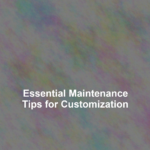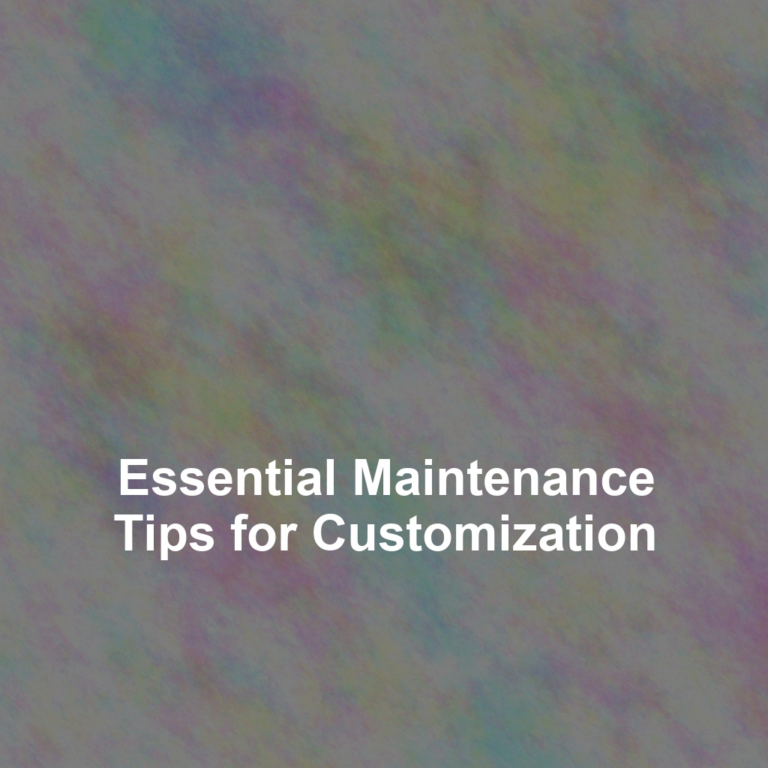When you invest in custom-made items, youG??re not just buying a product; youG??re embracing a piece of craftsmanship that reflects your personal style and needs. ItG??s essential, then, to consider how youG??ll maintain these unique pieces to ensure their longevity.
YouG??ve tailored your world with these bespoke itemsG??be it a custom-built motorcycle, a handcrafted piece of furniture, or a tailored suitG??so itG??s crucial to know the ins and outs of their care. Regular cleaning techniques, scheduled maintenance, and addressing wear and tear are all part of the puzzle.
But what are the specific steps you should take to preserve the quality and essence of your custom investments? And how can you prevent common pitfalls that might compromise their condition? Stay tuned, as the subsequent sections will guide you through the maze of maintenance, helping you to keep your customizations in pristine condition for years to come.
Understanding Your Custom Items
To fully appreciate and maintain your custom items, itG??s essential to grasp their unique capabilities and the care they demand. YouG??ve invested in these personalized pieces because they resonate with your style and needs. Understanding what materials theyG??re made of, the construction process, and the designerG??s intent helps you keep them in pristine condition.
If your items are crafted from special textiles, learn the dos and donG??ts of washing and ironing. Are they hand-stitched or machine-made? Delicate embroidery or intricate detailing requires gentle handling. For items with electronic components or mechanical parts, youG??ll need to familiarize yourself with their operation to prevent misuse that could lead to damage.
Keep in mind, exposure to certain elements like sunlight, moisture, or extreme temperatures can degrade your custom pieces faster than standard items. YouG??ll want to store them properly to extend their lifespan. Also, consider the use of protective treatments or cases, especially for items you use frequently.
Regular Cleaning Techniques
Regularly cleaning your custom items ensures they maintain their unique charm and functionality. Dirt and grime can obscure the intricate details that make your pieces special, so itG??s crucial to establish a cleaning routine thatG??s both gentle and effective.
For everyday cleaning, youG??ll want to start with a soft, dry cloth to remove surface dust. ItG??s your safest bet for most materials, as it wonG??t introduce moisture that could damage delicate finishes or electronics. If your item can handle a bit more, use a slightly damp cloth, but make sure to wring it out thoroughly to avoid water damage.
When dealing with stains or built-up grime, youG??ll need to be more selective. Always opt for mild cleaners that are appropriate for the material of your item. Harsh chemicals can wreak havoc on custom paint jobs and unique textures. If youG??re unsure, test the cleaner on a small, inconspicuous area first.
DonG??t forget the nooks and crannies! Use a soft-bristled brush or cotton swabs to get into tight spaces without scratching or displacing any small parts.
Scheduled Maintenance Checks
Beyond keeping your custom items clean, itG??s also vital to schedule periodic maintenance checks to ensure their longevity and optimal performance. Whether itG??s a bespoke piece of technology, a customized vehicle, or tailor-made furniture, setting a routine for these inspections can save you from future headaches and unforeseen costs.
Start by creating a maintenance calendar specific to your item. Depending on what youG??ve customized, certain components may need more frequent attention. For a car, you might check tire pressure and fluid levels monthly, while a software update for your customized app might be necessary every quarter.
DonG??t overlook the small parts. Even seemingly insignificant elements, like screws on a custom-built bike, can lead to bigger issues if they become loose. Incorporate a checklist into your routine that covers all the bases, from the software to hardware or structural integrity.
Lastly, engage with professionals when necessary. If youG??re not an expert in the field of your custom item, itG??s wise to have a skilled technician perform some of the more complex checks. TheyG??ll ensure everythingG??s functioning as it should and can spot potential problems you might miss.
Addressing Wear and Tear
Addressing wear and tear promptly ensures your custom items continue to function efficiently and look their best. ItG??s inevitable that your personalized possessions will show signs of use over time. DonG??t wait for a small scuff to become a significant tear; act as soon as you spot an issue.
Begin by inspecting your items regularly. Look for cracks, loose threads, or fading, which are telltale signs of wear. Once youG??ve identified the problem areas, itG??s time to take action. For fabric-based items, you might need to sew small tears or apply patches. Leather goods often require conditioning to prevent cracks and maintain their sheen.
If youG??re dealing with mechanical customizations, such as parts on a bike or car, lubrication might be necessary to keep everything moving smoothly. Tighten any loose screws and replace worn-out components before they fail. Remember, itG??s not just about aesthetics; itG??s about preserving the integrity and functionality of your custom pieces.
DonG??t forget to use the right tools and products for the job. Specialty cleaners and protectants can prevent future damage. And if youG??re ever in doubt, consult with a professional who understands the specific needs of your customized items. TheyG??ll offer advice or services to help maintain your unique possessions in tip-top shape.
Storage and Protection Strategies
After tackling immediate wear and tear, itG??s crucial to consider how properly storing and protecting your items can prevent future damage. YouG??ve invested time and resources into customizing your belongings, so itG??s essential to take steps to ensure they remain in top condition.
Here are four key strategies to keep in mind:
-
Use Protective Covers: Whether itG??s a custom car, a piece of furniture, or a gadget, using tailored covers can shield your items from dust, moisture, and sunlight, which can fade colors and degrade materials.
-
Control the Climate: Extreme temperatures and humidity can warp or crack certain materials. Store your items in a climate-controlled environment to maintain their integrity for as long as possible.
-
Avoid Overcrowding: When storing multiple items, give them enough space. Overcrowding can lead to scratches, dents, and pressure marks, especially on soft or delicate custom finishes.
-
Keep Them Clean: Before putting your items away, make sure theyG??re clean. Dirt and grime can become more difficult to remove over time and may cause permanent stains or damage.
Conclusion
YouG??ve mastered the art of personalizing your gearG??now keep it in prime condition.
Regularly wipe down surfaces, check for damage, and tackle repairs swiftly. DonG??t skop on storage solutions; theyG??re your itemsG?? best defense against the elements.
Remember, consistent care not only preserves your custom pieces but also your unique style. Show off your flair for years to come by giving your cherished items the TLC they deserve.
Your custom treasures are worth it!











